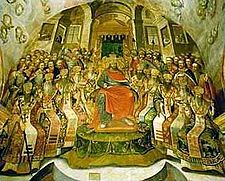
Gate Church of the Trinity (Pechersk Lavra)
Encyclopedia
The Gate Church of the Trinity is a historic church of the ancient cave monastery
of Kiev Pechersk Lavra
in Kiev
, the capital of Ukraine
. Originally being built as a Kievan Rus'
style church, the Gate Church of the Trinity is now decorated in the Ukrainian Baroque
style, having been reconstructed many times through its history.
, atop the main entrance to the monastery. The church was founded by the grandson of the Prince
of Chernigov
Sviatoslav II
, who renounced his princely status and became a Pechersk monk on November 17, 1106 under the name of Mykola Sviatosha. Mykola spent 36 years as a monk, and founded the Monastery Hospital of the Trinity within the Lavra.
After the destruction of the Dormition Cathedral during the Mongol invasion
of 1240, it became the main church of the monastery. In 1462, the most complete edition of the Kiev Pechersk Paterikcon was written here. In 1631, Petro Mohyla founded a school at the hospital monetary, which later was merged with the Kievan Brotherhood School. Since 1701, the combined school became a Kievan Academy.
The church was studied by P. Lashkarev, I. Morgilevsky, Yu. Aseev, F. Umantsev, and S. Kilesso. In 1957-1958, restoration efforts were conducted on the church, including the restoration of lost decor, gilding of the dome, and retouching of the external oil paintings.

.jpg)
 The church is located atop the Holy Gates , which houses the main entrance to the monstery. Near the entrance, there are rooms for the gate's guards. The church is wedged in between monastery walls, helping to protect the gates. The outer surface of the monastery walls leading to the gates are covered in frescoes. They were completely renewed in 1900-1901 by D. Sonin and others.
The church is located atop the Holy Gates , which houses the main entrance to the monstery. Near the entrance, there are rooms for the gate's guards. The church is wedged in between monastery walls, helping to protect the gates. The outer surface of the monastery walls leading to the gates are covered in frescoes. They were completely renewed in 1900-1901 by D. Sonin and others.
The Gate Church of the Trinity is divided into three nave
s, each of which contain spherical apse
s off their western side. An external stone stairway leads to the church Several narrow window openings and the overall visual uplifting effect created a heightened sense of spiritual power.
The church is a typical Kievan Rus'
construction, being built on an ancient stone church. However, Kievan Rus' architectural
motifs can still be seen on the southern façade
of the building. The church retains its current Ukrainian Baroque
exteriour after restorational works conducted in the 17th-18th centuries, done by Master V. Stefanovych. During the reconstruction, a different cupola was installed, and new interiour paintings were made. The initial ascetic appearance was replaced with an intricate and fanciful baroque style.
In 1725, a large sixteen-candle chandelier was installed. During the 1730s-1740s, a group of artists from the monastery's iconography workshop decorated the church's interiour. The church's frescoes were based on Biblical scenes
, and the exteriour decor was based on Ukrainian folklore. Eighteenth century compositions by F. Pavlovskyi, I. Maksimovych, and A. Galik (which help from M. Yakubovych and I. Kadelskyi) have been preserved to this day, including: "Faces of the Holy Martyr
," "The Traders Cast Out of the Temple," and "The Council of Nicaea
." The names of the painters remained unknown for many years, and only recently were revealed after archival research.
Interiour frescoes are a unique collection of 18th century traditional Ukrainian architecture. Allegorical and historical Biblical topics are given in a noncanonical way; some of them are made with Ukrainian national ornaments. Wood-carved chairs, executed in Ukrainian folk tradition, are installed along the western wall. The chairs are covered with oil paintings.
Cave monastery
A cave monastery is a monastery built in caves, with possible outside facilities. St. Anthony the Great known as the founder of monasticism lived in a cave.- List of cave monasteries :*Albania**St...
of Kiev Pechersk Lavra
Kiev Pechersk Lavra
Kiev Pechersk Lavra or Kyiv Pechersk Lavra , also known as the Kiev Monastery of the Caves, is a historic Orthodox Christian monastery which gave its name to one of the city districts where it is located in Kiev, the capital of Ukraine....
in Kiev
Kiev
Kiev or Kyiv is the capital and the largest city of Ukraine, located in the north central part of the country on the Dnieper River. The population as of the 2001 census was 2,611,300. However, higher numbers have been cited in the press....
, the capital of Ukraine
Ukraine
Ukraine is a country in Eastern Europe. It has an area of 603,628 km², making it the second largest contiguous country on the European continent, after Russia...
. Originally being built as a Kievan Rus'
Kievan Rus'
Kievan Rus was a medieval polity in Eastern Europe, from the late 9th to the mid 13th century, when it disintegrated under the pressure of the Mongol invasion of 1237–1240....
style church, the Gate Church of the Trinity is now decorated in the Ukrainian Baroque
Ukrainian Baroque
Ukrainian Baroque or Cossack Baroque is an architectural style that emerged in Ukraine during the Hetmanate era, in the 17th and 18th centuries....
style, having been reconstructed many times through its history.
History
The Gate Church of the Trinity was built in 1106-1108, as part of the Pechersk Lavra fortificationPechersk Lavra fortification
The Lavra fortification is a system of walls, towers and other constructions built for the protection of the Cave Monastery in Kiev, the capital of Ukraine.-History:...
, atop the main entrance to the monastery. The church was founded by the grandson of the Prince
Rulers of Kievan Rus'
Grand Prince of Kiev was the title of the Kievan prince and the ruler of Kievan Rus' in the 9th–12th centuries....
of Chernigov
Chernihiv
Chernihiv or Chernigov is a historic city in northern Ukraine. It is the administrative center of the Chernihiv Oblast , as well as of the surrounding Chernihivskyi Raion within the oblast...
Sviatoslav II
Sviatoslav II of Kiev
Sviatoslav Iaroslavich was the Prince of Chernihiv from 1054 to 1073 and Grand Prince of Kiev from 1073 until his death...
, who renounced his princely status and became a Pechersk monk on November 17, 1106 under the name of Mykola Sviatosha. Mykola spent 36 years as a monk, and founded the Monastery Hospital of the Trinity within the Lavra.
After the destruction of the Dormition Cathedral during the Mongol invasion
Mongol invasion of Rus
The Mongol invasion of Russia was resumed on 21 December 1237 marking the resumption of the Mongol invasion of Europe, during which the Mongols attacked the medieval powers of Poland, Kiev, Hungary, and miscellaneous tribes of less organized peoples...
of 1240, it became the main church of the monastery. In 1462, the most complete edition of the Kiev Pechersk Paterikcon was written here. In 1631, Petro Mohyla founded a school at the hospital monetary, which later was merged with the Kievan Brotherhood School. Since 1701, the combined school became a Kievan Academy.
The church was studied by P. Lashkarev, I. Morgilevsky, Yu. Aseev, F. Umantsev, and S. Kilesso. In 1957-1958, restoration efforts were conducted on the church, including the restoration of lost decor, gilding of the dome, and retouching of the external oil paintings.
Architecture

.jpg)

The Gate Church of the Trinity is divided into three nave
Nave
In Romanesque and Gothic Christian abbey, cathedral basilica and church architecture, the nave is the central approach to the high altar, the main body of the church. "Nave" was probably suggested by the keel shape of its vaulting...
s, each of which contain spherical apse
Apse
In architecture, the apse is a semicircular recess covered with a hemispherical vault or semi-dome...
s off their western side. An external stone stairway leads to the church Several narrow window openings and the overall visual uplifting effect created a heightened sense of spiritual power.
The church is a typical Kievan Rus'
Kievan Rus'
Kievan Rus was a medieval polity in Eastern Europe, from the late 9th to the mid 13th century, when it disintegrated under the pressure of the Mongol invasion of 1237–1240....
construction, being built on an ancient stone church. However, Kievan Rus' architectural
Architecture of Kievan Rus
The medieval state of Kievan Rus incorporated parts of what is now modern Ukraine, Russia, and Belarus, and was centered around Kiev and Novgorod. Its architectural style quickly established itself after the adoption of Christianity in 988 and was strongly influenced by the Byzantine...
motifs can still be seen on the southern façade
Facade
A facade or façade is generally one exterior side of a building, usually, but not always, the front. The word comes from the French language, literally meaning "frontage" or "face"....
of the building. The church retains its current Ukrainian Baroque
Ukrainian Baroque
Ukrainian Baroque or Cossack Baroque is an architectural style that emerged in Ukraine during the Hetmanate era, in the 17th and 18th centuries....
exteriour after restorational works conducted in the 17th-18th centuries, done by Master V. Stefanovych. During the reconstruction, a different cupola was installed, and new interiour paintings were made. The initial ascetic appearance was replaced with an intricate and fanciful baroque style.
In 1725, a large sixteen-candle chandelier was installed. During the 1730s-1740s, a group of artists from the monastery's iconography workshop decorated the church's interiour. The church's frescoes were based on Biblical scenes
Bible
The Bible refers to any one of the collections of the primary religious texts of Judaism and Christianity. There is no common version of the Bible, as the individual books , their contents and their order vary among denominations...
, and the exteriour decor was based on Ukrainian folklore. Eighteenth century compositions by F. Pavlovskyi, I. Maksimovych, and A. Galik (which help from M. Yakubovych and I. Kadelskyi) have been preserved to this day, including: "Faces of the Holy Martyr
Martyr
A martyr is somebody who suffers persecution and death for refusing to renounce, or accept, a belief or cause, usually religious.-Meaning:...
," "The Traders Cast Out of the Temple," and "The Council of Nicaea
The Council of Nicaea (painting)
The Council of Nicaea is an 18th century painting, by F. Pavlovskyi, I. Maksimovych, A. Galik, G. Karataev and others. It is presently hanging in the Gate Church of the Trinity in Kiev....
." The names of the painters remained unknown for many years, and only recently were revealed after archival research.
Interiour frescoes are a unique collection of 18th century traditional Ukrainian architecture. Allegorical and historical Biblical topics are given in a noncanonical way; some of them are made with Ukrainian national ornaments. Wood-carved chairs, executed in Ukrainian folk tradition, are installed along the western wall. The chairs are covered with oil paintings.

